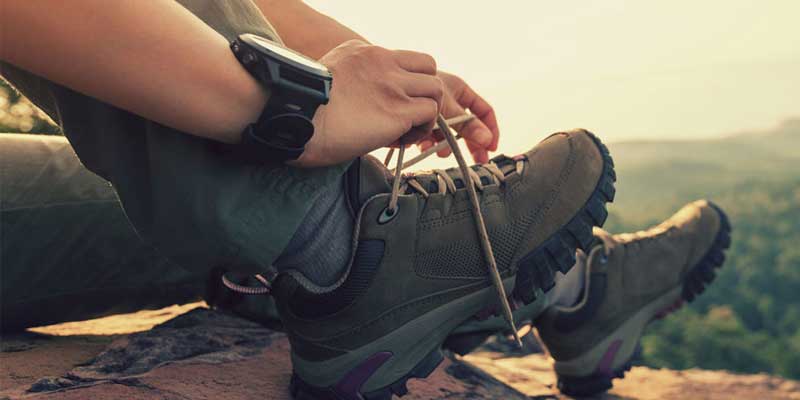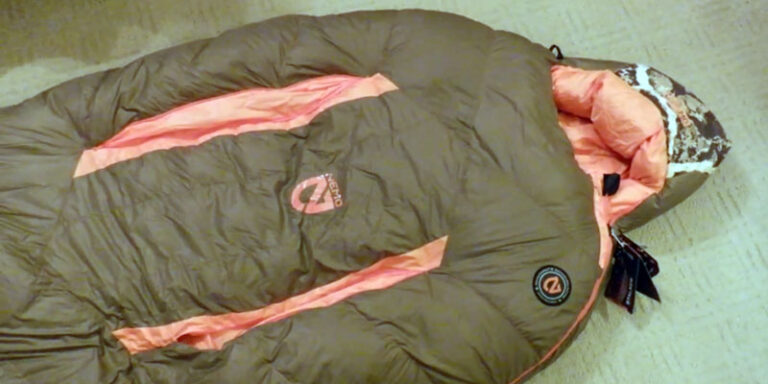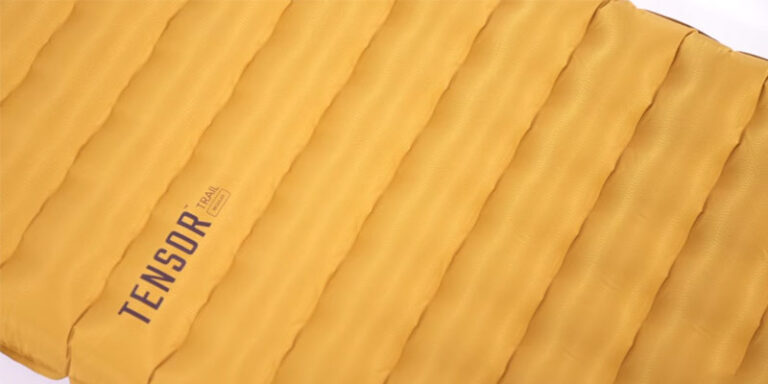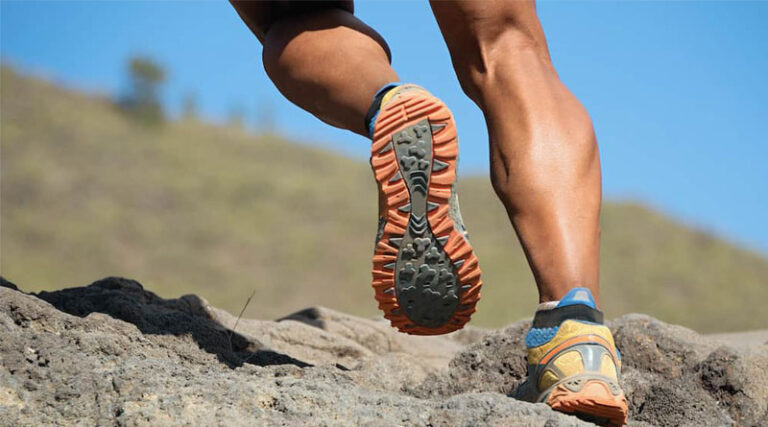Choosing the right pair of hiking shoes that fit well is important. When it comes to wide feet, you need to find out the precise width of your foot so that you can find a comfortable pair. Most thru-hikers think that sizes are limited to their length and getting the right length shoe means it will fit perfectly. However, this is not always the case. If you choose a narrow pair and you wear them for longer periods, you end up with blisters and deformed toes.
Shoes available in the market are made to “fit every foot”. Manufacturers assume that the general user has similar foot sizes. However, everyone has different foot sizes and shapes, and manufacturers do deviate from typical sizing so consumers with unusual foot shapes could also wear their shoes.
So here is the list of top wide hiking shoes for men and women.
1. Salomon X Ultra 4 GTX
Weight (Pair): 1 lb. 11.5 oz.
Waterproof: Gore-Tex
Upper: Synthetic
Midsole: EnergyCell
The Salomon X Ultra 4 GTX is a great choice for rugged trails. It is lightweight and agile, making movement easier. The GORE-TEX lining keeps your feet dry in wet conditions. Its Active Support “mobile wings” hold the foot securely, adapting to movement. The Advanced Chassis™ adds stability without restricting motion. The Contagrip® outsole grips well, even on wet and slippery surfaces. This helps a lot on steep descents. The shoe feels supportive and responsive, making it ideal for fast-paced hiking. Salomon recommends choosing a size larger than usual for the best fit.
However, the fit is not perfect for everyone. The midfoot is a little narrow, while the toe box is wide and spacious. Some may find it too tight at the arch but roomy at the front. The quick-pull lacing system is hard to adjust for a perfect fit. A raised collar around the ankle may cause discomfort for some users. While our testers had no issues, others might experience rubbing. If possible, try the shoes on before buying to ensure a good fit. Despite these concerns, the X Ultra 4 GTX remains a high-quality option. Its waterproofing, grip, and stability make it a strong contender for hikers. If the fit works for you, it is a reliable and durable hiking shoe.
What I like: Great balance of weight and on-trail performance.
What I don’t: Love-it-or-hate-it fit and comfort.
See the Salomon X Ultra 4 See the Women’s X Ultra 4
2. Oboz Sawtooth X
Weight (Pair): 2 lbs. 1.8 oz.
Waterproof: B-Dry
Upper: Nubuck leather
Midsole: Heel puck
The Oboz Sawtooth X Low Waterproof hiking shoes are a solid upgrade from the original. They keep the same great fit but offer better comfort, durability, and traction. The oiled nubuck leather and CORDURA® fabric mesh uppers provide a good mix of protection and breathability. Your feet stay dry thanks to the B-DRY waterproof membrane, which blocks moisture while letting sweat escape. The laces and webbing are made from recycled materials, adding an eco-friendly touch. The micro-injected polyurethane window underlay gives extra durability without adding weight. With an 8 mm heel-to-toe drop, these shoes feel balanced on uneven trails.
The fit is excellent, especially for people with high arches, wide forefeet, and narrow heels. The O FIT Insoles™ give great support, and I don’t feel the need for extra inserts. The heel cup keeps my foot secure without any slipping. I also have a small bump near my pinky toe that usually rubs, but these shoes accommodate it perfectly. The Adaptive Cushioning Technology midsoles and TPU heel counters add comfort and stability. Nylon shanks give extra protection underfoot, making rocky trails easier to handle. The True Tread rubber outsoles grip well on wet and dry surfaces. Overall, these are comfy and reliable hikers that handle tough terrain with ease.
What I like: Ideal choice for wide feet, require no break-in period, roomy toe box
What I don’t: A little heavy for backpacking.
See the Oboz Sawtooth X See the Women’s Sawtooth X
3. Merrell Moab 3
Weight (Pair): 2 lbs. 1.8 oz.
Waterproof: Merrell DRY
Upper: Pigskin leather/mesh
Midsole: Super Rebound Compound
Merrell Moab 3 shoes are lightweight backpacking shoes that will your hiking experience more enjoyable. The shoes are made of high-quality materials and the construction is super solid. When you put them on, you can feel that they are hiking shoes that would perform well and last a long time. The core of the shoe is rugged and provides lots of support and protection from technical terrain. The upper is durable suede leather and mesh. You also have a substantial protective rubber toe cap for added protection. Something you won’t necessarily find in cheaper shoes is the bellows. They are attached to a closed-cell foam tongue that’s going to help keep out moisture and debris.
Merrell Moab 3 is a premium hiking shoe and it provides excellent waterproofing. It has Merrell DRY, which seals out water but lets moisture escape so you stay dry when moving. Moab 3 features a Vibram sole with a 5mm lug depth that gives them an excellent grip on a wide variety of terrain. All of this adds up to a shoe that weighs in at 1 pound. Each of these features contributes to a very solid shoe that makes it very likely that this shoe will continue performing for many years to come.
What I like: Great traction, comfortable on most trails, durable
What I don’t: A little stiff, inflexible, and heavy
See the Merrell Moab 3 See the Women’s Moab 3
4. Danner Trail 2650
Weight (Pair): 1 lb. 8 oz.
Waterproof: No (GTX available)
Upper: Suede leather/textile
Midsole: EVA
The Danner Trail 2650 is a lightweight hiking shoe built for tough trails. It takes inspiration from the 2,650-mile Pacific Crest Trail. The upper is made of durable suede and breathable textile. A mesh lining keeps feet cool and comfortable. The EXO Heel System adds a secure fit with external heel support. Cushioning comes from the EVA PlyoGo midsole, which is soft and lightweight. The removable OrthoLite footbed helps with air circulation and heat dissipation. It has three layers of different densities for added comfort. The Trailguard TPU shank provides stability on rocky and uneven surfaces. With an 8 mm heel-to-toe drop, it offers a balanced feel for hiking.
Traction is a strong point of the Trail 2650. The Vibram 460 outsole has self-adapting lugs for grip on all surfaces. The Vibram Megagrip compound works well on both wet and dry trails. At just 1 pound 8 ounces per pair, this shoe is impressively light. It feels comfortable straight out of the box. Danner is known for work boots, but they are making great hiking shoes now. The Trail 2650 is not just functional—it looks stylish, too. It fits true to size and works well for many activities. Overall, this is a solid and versatile hiking shoe.
What I like: Comfortable, grippy, and looks good for casual use.
What I don’t: Expensive and can’t match the X Ultra above in stability.
See the Danner Trail 2650 See the Women’s Trail 2650
5. Altra Lone Peak 9
Weight (Pair): 1 lb. 6.4 oz.
Waterproof: No (GTX available)
Upper: Ripstop mesh
Midsole: MaxTrac rubber
The Altra Lone Peak 9 stays true to its roots. It is comfortable, lightweight, and built for the trails. The updated MaxTrac™ outsoles provide excellent grip, keeping you steady on tricky terrain. The Altra EGO™ midsole adds softness while keeping you connected to the ground. The ripstop mesh uppers and no-sew overlays improve durability, making them last longer on rough trails. The Original FootShape™ Fit gives plenty of room for your toes to spread naturally. The Stoneguard™ inserts add underfoot protection without making the shoe stiff. These features make the Lone Peak 9 a solid choice for runners and hikers who need comfort and performance.
However, long-time fans may notice a decline in durability. I’ve worn Lone Peaks since version 3, and quality has dropped over the years. My Lone Peak 7s fell apart on three out of four sides. I hoped for improvements, but nothing else fits me like these. I usually wear a size 9, but now I need a 9.5 for the right fit. The GaiterTrap™ tabs are still useful for keeping out debris. The zero-drop design feels natural and stable. While I appreciate the updates, I can’t ignore the shorter lifespan.
What I like: The Original FootShape™ design allows toes to spread naturally for better comfort.
What I don’t: Recent versions seem to wear out faster, especially for everyday use.
See the Altra Lone Peak 9 See the Women’s Lone Peak 9
6. HOKA Anacapa 2
Weight (Pair): 1 lb. 14.6 oz.
Waterproof: Gore-Tex
Upper: Nubuck leather/mesh
Midsole: EVA
The HOKA Anacapa 2 Low GTX is a lightweight and comfortable hiking shoe. It is designed with eco-friendly materials and upgraded features. The shoe has a recycled yarn mesh upper and a PFC-free water-repellent treatment. A GORE-TEX Invisible Fit bootie keeps water out while maintaining breathability. The shoe also features metal eyelets and a 100% recycled mesh vamp and quarter. The nubuck leather is gold-rated by the Leather Working Group for sustainability. An abrasion-resistant toe cap adds durability. The midsole contains 30% sugarcane EVA for a soft and cushioned feel. The Vibram Megagrip outsole provides reliable traction with its 5 mm lugs.
The updated version is more comfortable than the original. It has extra padding on the tongue and a softer midsole. The heel counter is less intrusive, making the fit more natural. The toe box is reinforced for better protection and durability. However, the outsole remains unchanged and still has large blown rubber sections. These sections can wear down quickly on rocky trails. The shoe also runs slightly larger than the previous version, so sizing down may be necessary. Despite these minor issues, the Anacapa 2 is a solid choice for hikers. It is best for those who prefer cushy comfort and mostly stick to well-maintained trails.
What I like: Cushy design is extremely comfortable; smooth ride.
What I don’t: Some outsole durability issues and polarizing looks; fit runs big.
See the HOKA Anacapa 2 See the Women’s Anacapa 2
7. KEEN Hightrail
Weight (Pair): 1 lb. 11.8 oz.
Waterproof: KEEN.DRY
Upper: Leather/mesh
Midsole: High-rebound foam
The KEEN Hightrail hiking shoes combine rugged durability with a lightweight, athletic feel. They provide excellent traction and support on any trail. The environmentally friendly leather comes from an LWG-certified tannery, ensuring cleaner water in production. The KEEN.DRY waterproof membrane keeps feet dry, even when stepping through deep puddles. A PFAS-free water repellent adds extra protection without harming the environment. Breathable mesh linings allow airflow, keeping feet cool on long hikes. A leather mud shield blocks debris, improving durability. These shoes also include Eco Anti-Odor technology, reducing smells naturally without pesticides. The Contoured Fit hugs the foot snugly for better comfort and control.
Right out of the box, they feel broken in and ready to wear. The foam strobel board and high-rebound foam cushioning provide excellent support. Removable foam insoles add long-lasting comfort, great for all-day hikes. The nonmarking KEEN.ALL-TERRAIN rubber outsole delivers high-traction grip on different surfaces. The multidirectional lugs offer superior stability, even on wet or loose ground. These shoes handle water impressively, keeping feet dry even when submerged. If you have normal or high arches, they may not provide the best fit. However, for those needing extra arch support, they feel incredibly comfortable. Overall, the KEEN Hightrail shoes are a fantastic choice for hikers wanting durability, comfort, and waterproof protection in one package.
What I like: Feels broken in right out of the box, no painful break-in period.
What I don’t: Might not provide enough arch support for some hikers.
See the KEEN Hightrail See the Women’s Hightrail
Wide Feet Hiking Shoes: Comparison Table
| Shoe | Weight | Waterproof | Upper | Midsole |
|---|---|---|---|---|
| Salomon X Ultra 4 GTX | 1 lb. 11.5 oz. | Gore-Tex | Synthetic | EnergyCell |
| Oboz Sawtooth X | 2 lbs. 1.8 oz. | B-Dry | Nubuck leather | Heel puck |
| Merrell Moab 3 | 2 lbs. 1.8 oz. | Merrell DRY | Pigskin leather/mesh | Super Rebound Compound |
| Danner Trail 2650 | 1 lb. 8 oz. | No | Suede leather/textile | EVA |
| Altra Lone Peak 9 | 1 lb. 6.4 oz. | No | Ripstop mesh | MaxTrac rubber |
| HOKA Anacapa 2 | 1 lb. 14.6 oz. | Gore-Tex | Nubuck leather/mesh | EVA |
| KEEN Hightrail | 1 lb. 11.8 oz. | KEEN.DRY | Leather/mesh | High-rebound foam |
How to Choose Hiking Shoes?
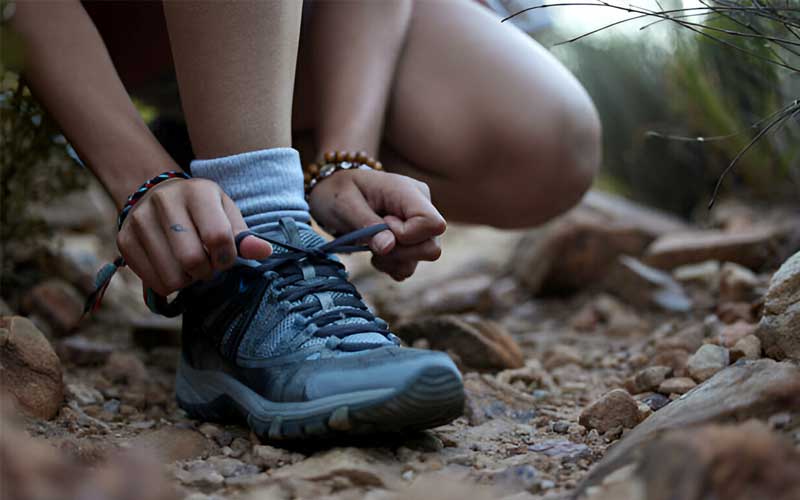
Hiking is an exciting outdoor activity that requires proper footwear. The right hiking shoes provide comfort, support, and protection. Choosing the best pair can be confusing with so many options. Understanding the key factors will help you make the right decision.
Know Your Hiking Type
Different hikes need different shoes. If you go for short hikes on well-maintained trails, lightweight hiking shoes are enough. For longer hikes with rough terrain, you need sturdy and supportive footwear. Backpackers carrying heavy loads require boots with strong ankle support. Knowing your hiking style will help you choose the right shoes.
Consider the Fit and Comfort
Comfort is the most important factor when choosing hiking shoes. A poor fit can cause blisters and discomfort. Try on shoes with hiking socks to get an accurate feel. Your toes should have some space to move, but the heel should not slip. Walk around to test the fit before buying. Also, try both men’s and women’s versions and you may find a better fit.
Choose the Right Material
Hiking shoes come in different materials, affecting durability and breathability. Leather shoes are tough and long-lasting but take time to break in. Synthetic materials are lightweight and dry faster but may wear out quicker. Waterproof shoes keep your feet dry in wet conditions but can be less breathable. Choose a material that suits your hiking environment.
Understand the Types of Hiking Shoes
There are different types of hiking shoes. Low-cut hiking shoes are good for light trails. They are lightweight and comfortable but offer less ankle support. Mid-cut hiking boots provide better ankle support and are suitable for moderate trails. High-cut hiking boots are best for rugged terrain and long hikes. They offer maximum support and protection.
Check the Sole and Traction
The sole of your hiking shoes determines grip and stability. Look for shoes with deep and well-spaced lugs for better traction. Rubber soles provide a strong grip on rocky and slippery surfaces. A stiff sole helps on rough terrain, while a flexible sole is good for easy trails. Good traction prevents slips and injuries.
Look for Proper Cushioning and Support
Hiking shoes should have good cushioning to absorb impact. A well-cushioned midsole reduces strain on your feet. EVA foam is lightweight and provides soft cushioning, while polyurethane is more durable. Arch support is important for long hikes. A well-supported foot prevents pain and fatigue.
Waterproof or Breathable?
Waterproof hiking shoes keep your feet dry in wet conditions. However, they can feel warm in hot weather. Breathable shoes allow air circulation, keeping your feet cool. If you hike in dry and hot areas, choose breathable shoes. For wet and cold conditions, waterproof shoes are a better choice.
Weight Matters
The weight of your hiking shoes affects your comfort. Heavy shoes provide better support but can be tiring. Lightweight shoes are comfortable for short hikes. If you carry a backpack, balance weight with support. The right balance helps in long hikes.
Break-in Period
New hiking shoes may need a break-in period. Wear them around the house or on short walks before a big hike. Breaking in helps the shoes mold to your feet. It prevents blisters and discomfort on the trail.
Price and Quality
Hiking shoes come in different price ranges. High-quality shoes cost more but last longer. Cheap shoes may wear out quickly and cause discomfort. Invest in a good pair that suits your budget and hiking needs.
Conclusion
The fit of the shoe is the most important thing especially if you have wide feet. No shoe is ideal if it doesn’t fit properly. They need to hold your foot securely in place and not let your heel rise as you step. At the same time, your toes must have a wiggle room so that they don’t hit the front as you go downhill. When you are going downhill, your toes are pushed forward and you don’t hit them in front of the shoe so a little room for your toes is a must. A good fit will avoid blisters and keep your feet happy, especially is the amount of gear you carry gets larger and when you go on longer hikes.
